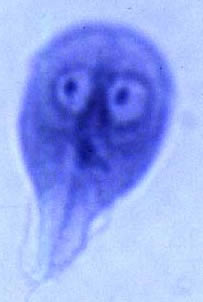
The life cycle of giardia is relatively simple. First, cysts are pooped out by a host (ie: animal or human) where they contaminate food and water supplies. They are then unknowingly ingested by a host. Once in the gut of the host, the cyst transforms into the trophozoite form. Trophozoites undergo asexual reproduction in the gut; as they reach the colon they re-encyst themselves. From there they are pooped out again to reinfect another unfortunate soul.
The trophozoite form has two nuclei (the two "eyes" in the photo to the right) and four pairs of flagella that allow it to move. The organism attaches itself to intestinal cells. How it causes symptoms is not entirely known. One possibility is that it causes inflammation of the intestinal cells resulting in a decreased ability to absorb nutrients from food.
Signs and Symptoms
Interestingly, most people infected by giardia lamblia are asymptomatic. However, in some individuals a foul smelling diarrhea results. The foul smell is due to steatorrhea (ie: undigested fat molecules). Many symptomatic people will also have belly pain, fatigue, flatulence, nausea, and possibly vomiting. All of these symptoms can give rise to weight loss.
Symptoms generally begin seven days after exposure. They generally last anywhere from two to four weeks with or without treatment. However, in a subset of patients who are untreated, symptoms may continue for months to years!
Diagnosis
Diagnosis is made most commonly by looking at the stool for proteins made by the organism (ie: giardia antigens). Also by looking at a stool sample under a microscope it is possible to directly see the trophozoites and cysts.
Treatment
Treatment is with an antibiotic known as metronidazole. This antibiotic is taken up by anaerobic bacteria and some protozoans where it is converted into toxic by products. These toxic metabolites damage DNA making the organism unable to divide; eventually, the damage causes cell death.
Overview
Giardia lamblia is a protozoan parasite that exists in two forms: trophozoite and cyst. The cyst is defecated and then ingested by another host. It turns into the trophozoite form and adheres to intestinal cells causing a foul smelling diarrhea in some individuals. Many people remain asymptomatic. Treatment is with an antibiotic known as metronidazole.
References and Resources
- Plutzer J, Ongerth J, Karanis P. Giardia taxonomy, phylogeny and epidemiology: Facts and open questions. Int J Hyg Environ Health. 2010 Sep;213(5):321-33. Epub 2010 Jul 8.
- Rópolo AS, Touz MC. A lesson in survival, by Giardia lamblia. ScientificWorldJournal. 2010 Oct 12;10:2019-31.
- Smith HV, Cacciò SM, Cook N, et al. Cryptosporidium and Giardia as foodborne zoonoses. Vet Parasitol. 2007 Oct 21;149(1-2):29-40. Epub 2007 Aug 28.
- Lujan HD. [Giardia and giardiasis]. Medicina (B Aires). 2006;66(1):70-4.
- Kumar V, Abbas AK, Fausto N. Robbins and Cotran Pathologic Basis of Disease
. Seventh Edition. Philadelphia: Elsevier Saunders, 2004.